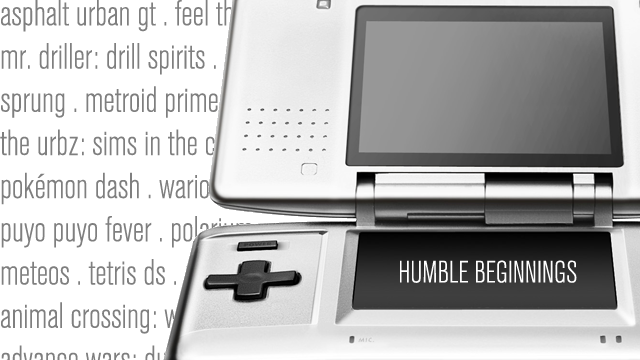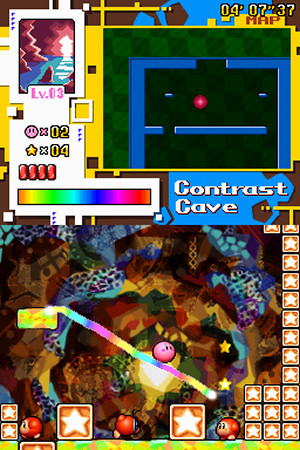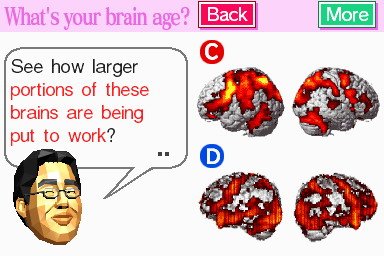
There’s plenty to talk about when it comes to Nintendo DS. The Nitro, the Developers’ System, the Dual Screen, the third pillar, the Game Boy replacement, Nintendo’s madcap triumph, the little handheld that could– the names may change, but some things will always stay the same. Two screens, locked in clamshell position, the bottom screen totally touchable and the upper screen playing straight man. One mic, placed wherever it wants to be– it’s the diva of the DS– and the rechargeable battery of the future, a long way from the Game Boy’s AA batteries. The ability to connect to Nintendo Wi-Fi Connection. And of course, the ability to play some of the craziest games around.
It’d be easy to simply write the DS off as a money-printin’ machine or a haven for games no normal developer would ever make, but just like in the greatest stories of our time, it wasn’t always that way. Our hero, the Nintendo DS, went through quite the adventure to get to where it stands now– on the shattered skulls of its enemies, with a crown that shines in colors beyond that of the visual spectrum. And as with any great story of any great game console, Nintendo DS could not follow this hero’s journey (so to speak) alone. It needed games. And only equipped with them could the Nintendo DS begin its long and winding road toward video game royalty.
In accordance with video game law, the video games released at launch with a console must consist of at least one relatively decent game, with the rest of them rating anywhere from a 7 to a 10 on the Scale of Pretty Bad Games. There’s no exception here. Yes, November 21, 2004, wasn’t necessarily the best day for our hero, and certainly not for DS enthusiasts; though they had Super Mario 64 DS, and indeed were probably pretty happy with it (folks, we’re talking about a port of Super Mario 64, except with Wario), they also had to deal with drivel like Ubisoft’s Sprung and THQ’s Ping Pals. Not to say that Super Mario 64 DS was exactly a diamond in the rough, either– considering it was a three-dimensional game, except controlled by digital input, unless you wanted to rub your stylus or your strap-nub all over your screen in lieu of analog input, we can only look at SM64DS as the lesser of many evils.
The thing is, though the games released for the DS in late 2004 certainly tried to be creative– rarely does one ever see a Western company go for a dating sim, and Ping Pals at least tried to be interesting to the crowd who already had PictoChat– they often gave up halfway through their creativity. Super Mario 64 DS had its analog input and its somewhat entertaining collection of minigames; Ping Pals had PictoChat (Ping Pals Edition); The Urbz experimented with touchscreen input that– well.
Actually, there were some interesting usages this early in DS development. While The Urbz certainly isn’t anything new in terms of gameplay, its showing vital information on the bottom screen certainly foreshadowed future games’ usage. Mr. Driller: Drill Spirits even managed to incorporate an alternative control scheme via the touch screen, as well as expanding the game’s real-estate twofold by extending the game’s field of play to the bottom screen, mimicked later on by games such as Tetris DS and even role-playing games like Lunar: Dragon Song.
Sure, developers were still wary of spending too much time developing for the touch screen, and at this point they might have even started to wonder just why they spent resources on making games for this crazy handheld. But as far as launches go, the DS didn’t have such a terrible one. At the very least, it brought hope for 2005.

By March of 2005, our hero had already found his rival, and just like all rivals, this one had chosen the Pokémon against which our hero was weakest. Sony’s Playstation Portable was both faster than and graphically superior to Nintendo DS, and to top it all off, boasted the ability to play music and movies with its storage capabilities and its proprietary UMD format. Here was a system that could dominate in not only the video game aisle at the local department store, but also the media section. Many a gamer, fresh from the console wars of the PS2, GCN, and Xbox, were prepared to call it. PSP would win this round, definitely.
But our hero did not falter. Here, Papa Nintendo summoned the will and the third-party developers to carry on. Suddenly, the touch screen seemed like it was worth something; games like Polarium and Meteos took over an audience who didn’t know they liked puzzles until they could actually touch them, and especially in the case of Meteos, inspired gamers to make their friends buy DS systems just so they could fire some crate rockets at them. (With their touch screens, of course.) Companies like Konami, previously touted as friends of Nintendo DS, proved their worth with quirky games like Lost in Blue, which provided handheld gamers with the chance to explore a not-quite-Ico-but-still-interesting world fraught with danger and touch-screen minigames, while proving that games could successfully pull off a hybrid of touch capabilities and button pressin’ with minimal danger. And of course, the Advance Wars series had to make a comeback on the DS, giving The Urbz and Mr. Driller a what-for by using the top screen for vital information (or just maps) and the bottom screen for real-time strategy touchin’. Here were the games that early DS adopters were waiting for.

You’re not Kirby, but you keep him alive more than ever in Kirby: Canvas Curse.
Finally, our hero found his final saving grace of this first round with the PlayStation Portable: Kirby: Canvas Curse. The premise was simple, even if it was already touched upon (ahem) by games such as Yoshi Touch & Go— players used their stylus to draw a road upon which Kirby would roll and roll until he reached the end of the level, while smashing enemies open and stealing their powers at the same time. This particular form of gameplay exemplified two tenets of DS game design that would last the test of time. First: that simplicity was key when using the touch screen. Oh, sure, complexity had its uses, but Kirby: Canvas Curse wouldn’t be nearly as good a game if the player had to build a structurally sound roller coaster for Kirby to roll on instead of just a line of rainbows. And secondly: that the touch screen should establish a tangible bond between the player and the game. In Super Mario 64 DS, sure, Mario got around because the player moved him with a stylus or, more likely, a directional pad– indirect control. But in Kirby: Canvas Curse, Kirby moved because the player actually, well, moved him. It was only because the player provided a road on which Kirby could travel, and loop-de-loops for Kirby to dash across, that Kirby could move at all. If Kirby fell into a pit of lava, it wasn’t because the button got stuck or the game didn’t respond to a press fast enough– it was because the player did not create a road for him. The player is both impetus and catalyst in Kirby: Canvas Curse, and both victory and defeat are palpable. It’s no wonder Nintendo offered a pink stylus to anyone who bought the game: it was a weapon for Kirby’s very survival.

But the lessons Kirby: Canvas Curse were not heard from everyone. In fact, for a while it seemed like nobody really cared what Kirby had to say about anything– not that it mattered to gamers, because suddenly everybody wanted a piece of our hero. Fortunately, Nintendo DS didn’t seem particularly adept at fighting games off, and companies like Capcom and Konami sent in their best bets. Phoenix Wright came with a reputation that preceded him, fresh– well, not exactly fresh– but hailing from Game Boy Advance games that didn’t quite make it outside of Japan, and quickly made his good name even better with localization that smacked of pure, unadulterated hilarity. Capcom did a ridiculously good job localizing all the cultural references in Ace Attorney— and managed to trick everybody into thinking that it wasn’t just an interactive novel that they were reading. Suffice it to say that Ace Attorney‘s success (as well as the lesser success of contemporaries Trace Memory and Hotel Dusk: Room 215) paved the way for other exploratory games in its genre, from Jake Hunter to Professor Layton.
But it wasn’t just the Ace Attorney series that saw a revival. Our hero suddenly saw an insane amount of games that may have sounded like mere sequels, but in many ways happened to be the pinnacles of their respective series. Sonic Rush, a two-dimensional Sonic game in the midst of three-dimensional horrors like Shadow the Hedgehog, garnered a wide-eyed following and shocked slack-jawed critics as they typed up rather positive reviews that mostly consisted of sentences like “boy howdy is this surprising” or “I didn’t know Sonic Team still made good games.” (Here’s a secret: Dimps did most of the work.) Castlevania: Dawn of Sorrow, though somewhat bemoaned for its complete change of artistic style from prior Castlevania games (Soma, we hear, swears that he looked like this all along), made people happy with its soul-snatchin’, screen-tappin’ (when you had to– it was a gimmick) gameplay, and even boasted Julius Mode, in which gamers played through the game again as three characters straight from the Castlevania archives.
And of course, it wasn’t just Mario Kart DS that showed the world that Mario Kart is still fun even after all these years, but equipped with Wi-Fi capabilities, gamers could show the world, too– that is, if they felt comfortable driving their karts around in an increasingly cutthroat environment. (Some of us still get angry about those gosh-darn “snakers”.) Finally, Animal Crossing: Wild World, continued to make fruit-picking and shell-searching seem fun, while adding new characters and a brand new world of holidays and items– not to mention, of course, opening the door to allowing faraway gamers to hang out right in each other’s neighborhoods. Even with Friend Codes, Nintendo Wi-Fi Connection finally had a purpose. Meanwhile, our hero itself continued to play host to a somewhat unexpected revival of some of gaming’s most revered franchises– and nobody was complaining.

Of course, we couldn’t tell our hero’s journey in full without mentioning the little phases he went through along the way. Sure, the likes of Phoenix Wright: Ace Attorney and Kabu Trader Shun (like Phoenix, except with the stock market instead of the courtroom) were pretty quirky, but what about Nintendogs? What about Cooking Mama? And, dare we mention Elite Beat Agents? Nah, that’d be pushing it.
Except that pushing it was what the Nintendo DS was all about– whether it was in games like Kirby: Canvas Curse or Animal Crossing: Wild World. And just as the DS previously made gamers realize the inherent worth of the series they had enjoyed so much before, or the incredible ability of the touch screen to work with gaming in a way hitherto unseen, so did our hero manage to bring even non-gamers into the fold– and it didn’t even have to drag them. The way Papa Nintendo did this is a story that every handheld gamer has heard by now– it abused the incredible power of cuteness. And it’s no ordinary cuteness we’re talking about. We speak of Nintendogs. Parents, Nintendojo knows, don’t always have the best things to say about video games. But hand them a copy of Nintendogs and– boom!– you may as well have handed a six-year-old Pokémon Black. (And that’s before release.)
Meanwhile, games like Picross DS and Cooking Mama supplemented the “is-this-a-game-are-you-sure?” action to the point where you could easily step into public transit only to find old ladies cooking just like Mama– that is, people who normally condemned video games suddenly started playing them. Looking back, this probably contributed to that “aha!” moment, when Nintendo learned that it could take over even more of the world than it already had. In fact, that’s probably the whole point of Elite Beat Agents— Nintendo was trying to tell the world that only Nintendo could save it from the treachery of aliens like Microsoft or Sony. Through the power of music. Really.

Turning the DS on the side made it more familiar– it became like a book instead of a console.
But of course the most famous of these games, which so seemingly easily propelled casual gaming into the couch of comfort, is Nintendo’s Brain Age: Train Your Brain in Minutes a Day!. Whether or not this really works to help people keep their brain young is debatable, certainly– but just as Animal Crossing tricks gamers into thinking paying off mortgages is fun, so does Brain Age tell gamers that math and Sudoku is just as fun as beating people up in Street Fighter. And for a while, the world seemed to agree. Television news anchors suddenly were playing Nintendo DS systems on set, trying to see if they could beat the other networks’ anchors, or at least best their spouses; psychologists who were secretly gamers finally had a reason to say that games are good for you. Brain Age, the classic not-a-real-game, managed to outsell all too many “real games”, and won the hearts of each buyer in the process.

We’ve mentioned so many games already, and yet our hero still isn’t finished with his journey. Plenty of quality games are coming out– in the next month alone!– and each of them exemplify a certain trait that our hero has perfected over the years. Chunsoft’s 999: Nine Hours, Nine Persons, Nine Doors, released late last year (okay, so it’s not “yet to come”, but you should still play it), shows all the majesty that came with Professor Layton or Ace Attorney‘s wondrous localizations and witty writing; Radiant Historia follows a proud tradition of role-playing games that have managed a SNES-style comeback on the Nintendo DS (only a RPG renaissance could cause a port of Chrono Trigger); Okamiden is shaping up to be a vast improvement on the touchscreen controls hearkening all the way back to Super Mario 64 DS and Lost in Magic; Pokémon Black and White are, well, Pokémon games, though with an actually robust global Wi-Fi battle functionality in the footsteps of Mario Kart DS; and Monster Tale, though certainly not one of the best-known games around, happens to be quite the looker with two-dimensional sprites, dual-screen juggling a la The World Ends With You, and the kind of gameplay gamers round these parts would call killer.Yep, there’s a lot of games coming out– but the Nintendo DS can take it.
Yet still, dear reader, out hero can’t do this alone. Now that we’re in the last month– the last month!– before the 3DS comes out, all these games run a risk of Drill Dozer syndrome– that is, releasing so far into the lifespan of the Nintendo DS that they will remain forever forgotten. With games like Radiant Historia or 999, such a fate would be simply criminal. Nintendojo has done its best to show how every step of our hero’s journey has perfected it into a powerhouse that nobody saw coming– while its rival, who chose the Squirtle to our hero’s Charmander, has fallen by the wayside. It’s up to you, now, to keep our hero going.




 ShareThis
ShareThis








Great article, I really enjoyed it!! The pictures are awesome too. It’s a nice reminder that things werent’ always as they are now, and at one point DS had it pretty rough.
To be honest, while researching this article I was surprised to remember that certain games even existed (Sprung and Ping Pals, for example, were very much hanging around in the attic of my mind). But even those games add just a little bit of crazy to the Nintendo DS, especially now with all the triple-A titles out for it. Definitely quite humbling.